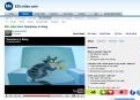Cargando...
Recursos educativos
-
Nivel educativo
-
Competencias
-
Tipología
-
Idioma
-
Tipo de medio
-
Tipo de actividad
-
Destinatarios
-
Tipo de audiencia
-
Creador
-

Unit 11: The Earth's population
EduBook Organización
- 7405 visitas
Active population (n): the part of the population that is of working age. aging population (n): when the average age of the population increases. This happens when people live longer and have fewer…
-

English Exercises: Adjective Order
Nancy Acuña Valladares Docente
- 1 lo usan
- 2330 visitas
adjectives exercise. In English, the adjective is used before the noun and, if we use more than one, the adjectives must follow the correct order. This OE was made especially for students who, in their…
-

Reproduction in plants
EduBook Organización
- 6244 visitas
Plants reproduce Plants use their flowers to reproduce. Flowers have two main parts: The stamens. These contain the pollen grains. The pistil. This contains the ovules. When pollen grains fall on the…
-

Check. The industrialisation of European societies
EduBook Organización
- 1 lo usan
- 5671 visitas
Remember what you have studied in this unit and answer the questions: What is meant by the Industrial Revolution? What changes did it cause in agriculture and demography? Explain what innovations led to…
-

Check. The representation of the Earth
EduBook Organización
- 1 lo usan
- 5643 visitas
Remember what you have learnt in this section and answer the questions: Why is it important to know a map's scale? What are the two types of map scale and how are they different? When are large…
-

Introduction - Landscapes
EduBook Organización
- 1 lo usan
- 5634 visitas
Everything we see around us is the landscape. Landscapes have natural features, like rivers, trees, lakes, mountains and beaches. Landscapes also have man-made features, like houses, roads, bridges and…
-

The natural environment
EduBook Organización
- 5742 visitas
The place where a living thing lives is called a habitat. When we study a habitat, we look at the living things (animals and plants) that live there. We also look at the non-living things around them.…
-

Check. Internal forces in the formation of relief
EduBook Organización
- 5692 visitas
Remember what you have studied in this section and answer: Which internal forces form the Earth's relief What can the cone of a volcano become after an eruption? Give an example. Look at the map and…
-

Complete. Net immigration rate
EduBook Organización
- 5625 visitas
Complete the text about net immigration with the missing words: A country has a when there are more people entering the country than leaving it. This influences the country in many ways: there is an in…
-

Video: Symphony in Slang
Esl video Organización
- 2 lo usan
- 5950 visitas
This hilarious 7 minute cartoon tells the whole story of a man's life in idioms, for example: "The cat got your tongue", "she ate like a horse"... Each step is taken to baffling new…
Te estamos redirigiendo a la ficha del libro...











